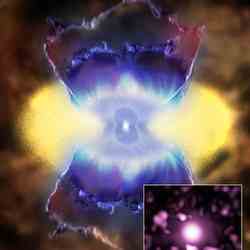An illustration showing a quasar at the center of the galaxy. Image credit: NASA
Click to enlarge
Sometimes the supermassive black holes at the hearts of galaxies are quiet, and nearly invisible. Other times they're actively gobbling up material, blazing as quasars in the X-ray spectrum. NASA's Chandra X-Ray Observatory has observed one of these transition times, when the heated material around the supermassive black hole is beginning to ignite. It's likely the galaxy recently collided or merged with another galaxy, and the turbulence caused material to fall into the black hole.
An artist's illustration depicts a quasar in the center of a galaxy that has turned on and is expelling gas at high speeds in a galactic superwind. Clouds of hot, X-ray producing gas detected by Chandra around the quasars 4C37.43 and 3C249.1, provide strong evidence for such superwinds.
The X-ray features seen at five, six, ten and eleven o'clock in the 4C37.43 image are located tens of thousands of light years from the central supermassive black hole that powers the quasar. They are likely due to shock waves in the superwind.
Mergers of galaxies are a possible cause for the ignition, or turn-on, of quasars. Computer simulations show that a galactic merger drives gas toward the central region where it triggers a burst of star formation and provides fuel for the growth of a central black hole.
The inflow of gas into the black hole releases tremendous energy, and a quasar is born. The power output of the quasar dwarfs that of the surrounding galaxy and pushes gas out of the galaxy in a galactic superwind.
Over a period of about 100 million years, the superwind will drive most of the gas away from the central regions of the galaxy, quenching both star formation and further supermassive black hole growth. The quasar phase will end and the galaxy will settle down to a relatively quiet life.
Chandra X-ray Observatory
 Universe Today
Universe Today
